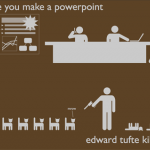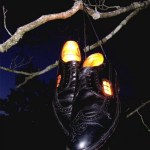blogosphere
This is weirdly awesome. It's the Google Translation of a short web essay by Franco Bolelli. Entitled "Farewell to the scientist with his head in the clouds, now prefer to surf: the science has become pop," the article is pretty awesome, but that's probably in part because it was translated by a bot, giving it a kind of cyber-Italian accent on the screen.
Do you remember the proverbial stereotype of the scientist screwed with his head in the clouds, perched in his laboratory dealing with mysterious formulas? Well, has also done the end of the phone booths or VCRs, finally lost in the stormy…
A slight science journalism FAIL in a story at iO9, originally from the New Scientist:
the Title: "First Quantum Effects Seen in Visible Object"
the Lede: "Does Schrödinger's cat really exist? You bet. The first ever quantum superposition in an object visible to the naked eye has been observed."
the Discovery: "[researchers showed] that a tiny resonating strip of metal - only 60 micrometres long, but big enough to be seen without a microscope - can both oscillate and not oscillate at the same time."
the Wait, what?: "Alas, you couldn't actually see the effect happening, because that very…
A few thoughts on this ad I spotted last week in Boston:
1. Yes, that appears to be a giant gel electrophoresis. Geez, this town is nerdy.
2. I hope that attractive woman is supposed to be a genetics PhD. Because we're all supermodels.
3. Why didn't I ever think to do a random restriction digest and blot on my own DNA back when I was in the lab 18 hours a day, so I could false-color it in Photoshop, hang it above the mantel, and brag about my trendy home decor? Bah! I suppose maybe there were rules about that sort of thing.
4. The loft development website asks, "What's your design DNA"?…
--A great NYT article on science museums and cabinets of curiosities:
This antic miscellany is dizzying. But there are lineaments of sustained conflict in the apparent chaos. Over the last two generations, the science museum has become a place where politics, history and sociology often crowd out physics and the hard sciences. There are museums that believe their mission is to inspire political action, and others that seek to inspire nascent scientists; there are even fundamental disagreements on how humanity itself is to be regarded. The experimentation may be a sign of the science museum's…
Hi everyone,
I'm officially back from blogcation this week, so thanks for hanging in there while I was (mostly) off the grid! For the next couple of weeks, I'll be slowly wading through the emails and links I got during over the last few weeks.
Plus, I'll not only be posting at BioE, I'll also be contributing over at Collective Imagination, which is focusing this month on technology and personal health, including data visualization and e-health. (These are big interests of mine that I occasionally touch on here at BioE, but are a squarer fit over at CI.) Please pop over and see what you…
While I was on blogcation, I got an email from the watchdog group Stinky Journalism, complaining that prominent science author and professor Jared Diamond (Collapse, Guns, Germs and Steel) was in the hot seat again. (You may remember that Stinky Journalism broke the story about the lawsuit against Diamond arising from his New Yorker piece on tribal violence in New Guinea; I blogged about the fallout of the controversy here and here.)
Really? I thought; what has Diamond supposedly done this time? Here's the scoop from Stinky Journalism:
[In] the February 18 issue of the journal Nature . . .…
One of my pet peeves is the idea that BMI provides an accurate indication of individual health. It doesn't. It's useful across populations (and may be useful to individuals to monitor progress), but when it comes to indicating which individuals are "healthier", BMI fails miserably - and our new Sciblings at Obesity Panacea do a great job of explaining why.
If, as a policy matter, we want to differentiate between the healthy and unhealthy - which is a big if, depending on how libertarian you are - let's make such assessments meaningfully, using a workout that proves general endurance and…
By Joseph Hewitt, who clearly understands the Sb atmosphere quite well.
Update: welcome Consumerist readers! While I use my own experience to illustrate concerns about third-party online merchants, this post is mainly about the bigger long-term informational problems I see with reputation, reliability, and online communities. Please feel free to weigh in!
A few weeks ago, I caught a familiar story on the local news. A local citizen had written in to the news team with a request for help after a local furniture company sold them a defective living room set, and wouldn't give them a refund. The news team went to the business, who - wary of the potential public…
A friend of mine recently turned me on to the great street art blog Wooster Collective. Check out this unexpected street art in Richmond, Virginia: pairs of old shoes dangling in trees seem mundane by day, but by night, they're like streetlamps from a Tim Burton cartoon. Solar panels inside the shoes supply the light. No idea who the creator is.
Check out more stealth art at Wooster Collective.
An interesting post from Repository for Bottled Monsters gathers together a few links on art/exhibit censorship, like this opinion, "Why Some Art Should Be Censored," from the Shreveport Times: "Another sort of case concerns the use of human corpses in art. There is a venerable tradition of showing the dead for various reasons, as in Rembrandt's famous The Anatomy Lesson of Dr. Tulp or Goya's depictions of the horrors of war -- not to mention numerous crucifixions. . . "
Google may have done Buzz all wrong, but they do Chrome right in these adorable, Rube Goldberg-style ads.
Jesse ("Jess3") Thomas's brand-new clip, like a slimmed-down, retro-styled, updated cousin of that ubiquitous "Right here, right now" video, is the perfect appetizer to complement the Pew's brand-new report on participatory news. Enjoy.
A provocative post over at the Intersection.
I haven't had time to weigh in on the vitriol-slinging because I'm on blogcation - and honestly, the stuff Sheril describes is one of the very reasons I decided to take a blogcation. But knowing that I'll be attacked for saying it, yes, I agree with her that hateful ad hominem attacks are increasing in the science blogosphere, it's nauseating, and it doesn't reflect well on any of us.
A physicist with a baby iceberg in Qaanaaq, Greenland. (I think its enraged mother is just out of range of the camera, about to crush him.)
Via Armed with Science.
In Cambridge, at a "Wireside chat" on "Fair Use, Politics, and Online Video" by legal scholar, IP expert and corrupt-government critic Lawrence Lessig. He's comparing the addictivity/potential danger of wifi to smoking. Say it ain't so! I need my wifi!
This year's version of the science blogging anthology, The Open Laboratory 2009, is out and available from Lulu publishing. You can order it in paperback format or as an electronic download. Three cheers to editor Scicurious and series editor Bora Zivkovik for their great work in making this happen!
For more, check out Scicurious' announcement and the earlier unveiling of the posts included in this year's anthology. You can see my contribution here.
So I flatter myself that you *might* be missing lil' ol' me during my blogcation. (Come on, throw me a bone here). But there's a new sibling who might distract you - Claire Evans, "a freelance science writer, science fiction critic, polymath, and musician," who also blogs about the intersection of science and the arts! Yay! Go say hello at Universe.
FYI: the winners of the AAAS Science and Engineering Visualization Challenge are up! You may recognize some of them - including PhD (Piled Higher and Deeper) cartoonist Jorge Cham. Check 'em out and share your opinions; I'll have more to say when I'm back from blogcation!





